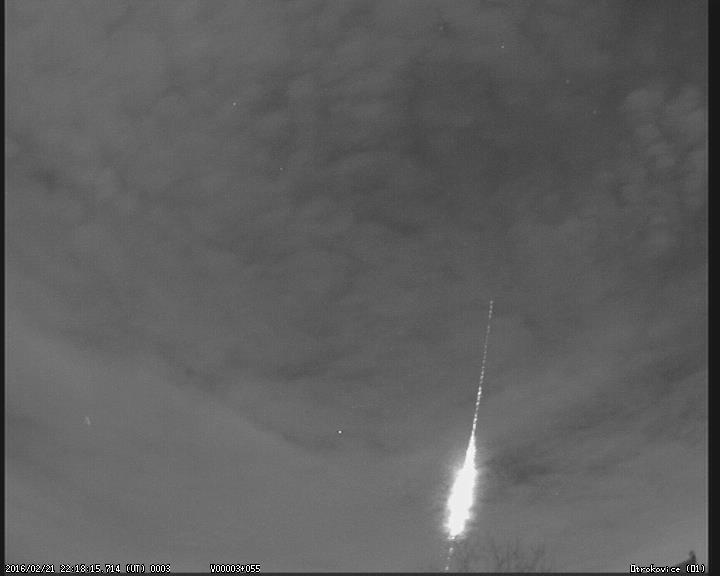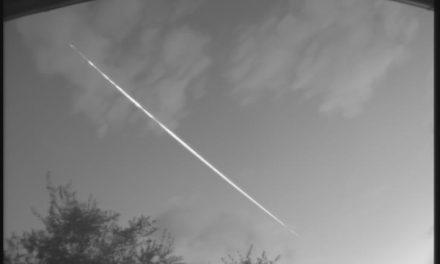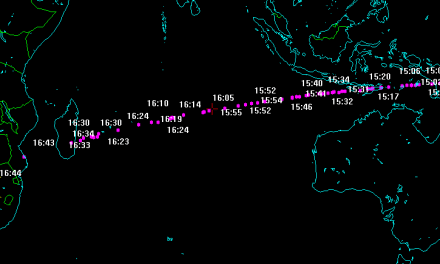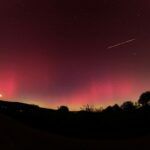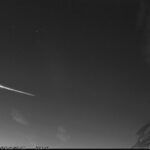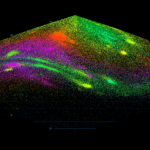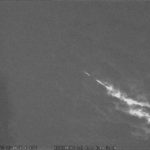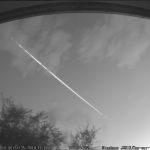The weak june ro-Drakonid meteor shower (JRD, IAU MDC 0686) was first described in 2018 (P. Jenniskens) based on trajectory analysis of only 23 members of this shower. It is a meteor shower of cometary origin with a parent body a long-period comet (comet group 1P/Halley) with the radiant in the constellation Draco. Therefore, meteors of this shower are not often observed, and even rarer are bright bolides, such as the bolide 20240602_204346, which was observed by the CEMeNt (Central European MetEor NeTwork) cameras.
VIDEO OBSERVATION OF THE BOLIDE
The bolide 20240602_204346 was recorded by the CEMeNt network cameras on 2/6/2024 at 20h43m46.1 ± 0.1s UT. As part of the CEMeNt (Central European MetEor NeTwork) network, the bolide was recorded directly on six wide-field cameras (Fig. 1-6). The flight record of the bolide is available from the stations Valašské Meziříčí SW and SE (CZ, Valašské Meziříčí Observatory), Ždánice E (CZ, Ždánice Observatory), Maruška SE (CZ, Jakub Koukal), Jablonec N (SK, Jakub Kapuš) and Partizánske NE (SK, Partizánske Observatory). In addition to these stations, the spectrum of the bolide’s flyby was recorded by spectrographs at the Valašské Meziříčí Observatory (spectrograph VM_SPSW and VM_SPSE), which is key for determining the chemical properties of the body.
ATMOSPHERIC TRAJECTORY, RADIANT AND HELIOCENTRIC ORBIT
Recordings taken from the stations Valašské Meziříčí (SE and SW), Maruška SE, Ždánice E, Jablonec N and Partizánske NE were used to calculate the atmospheric path of the bolide and the orbit of the meteoroid in the Solar System. The recording from these stations was made by the UFOCapture program, the processing of the recording in the UFO Analyzer program and the calculation of the atmospheric and heliocentric orbit in the UFO Orbit program (SonotaCo, 2009). The projection of the beginning of the atmospheric path was located at the coordinates N48.9217° E18.4652° southeast of the village of Zliechov (SK) in the heart of the Strážovské vrchy, the height of the meteor at that moment was 107.0 km above the Earth’s surface. The projection of the end of the atmospheric path was located at the coordinates N48.7353° E18.2481° north of Bánovce nad Bebravou (SK), the height of the meteor at this moment was 77.2 km above the Earth’s surface (Fig. 7). The bolide reached an absolute brightness of -6.0m at a height of 77.8 km above the Earth’s surface and traveled a distance of 39.4 km in the Earth’s atmosphere during 1.1 s of flight.
The body entered the Earth’s atmosphere at an ideal angle of 49.1°, the speed before entering the atmosphere was 36.62 km/s. It was therefore a medium-speed bolide, the geocentric speed of the meteoroid was 34.75 km/s. The body belonged to the june ro-Draconids meteor shower (IUA MDC 0686 JRD). Before entering the atmosphere, the body moved along an elongated prograde orbit (Fig. 8) with a high eccentricity e= 0.955, a relatively high inclination to the ecliptic plane i= 55.73° and a perihelion q= 1.0071 AU. The body was of cometary origin with an unknown parent body that belonged to the long-period comets of the 1P/Halley group.
PHYSICAL PROPERTIES OF THE METEOROID
In the case of bolide 20240602_204346, the estimation of the initial mass of the body and its other physical properties can be based on the heliocentric orbit elements, the atmospheric orbit, and also the chemical properties obtained from the analysis of the spectrum of the bolide from the spectrographs VM_SPSW and VM_SPSE (Fig. 9, 10). For the initial determination of the parameters of the heliocentric orbit of the meteoroid, the Tisserand parameter of the path in relation to Jupiter was calculated. Depending on the value of the Tisserand parameter, the inclination of the path and the aphelion distance, the bodies can be divided into 4 groups. Bolide 20240602_204346 has the value of the Tisserand parameter TPJ= 0.925, according to this classification, the bolide belongs to the HT group, i.e. to the group of meteoroids with a cometary origin and a long-period parent body (comet group 1P/Halley). According to the KB parameter (6.785), which is a function of material properties and surface temperature (Ceplecha, 1968; Ceplecha and McCrosky, 1976; Ceplecha 1988), it belongs to group C2 (common long-period cometary bodies). According to the PE parameter (-5.564), the bolide belongs to group IIIAi (again, common long-period cometary bodies). Using the parameters that characterize the shape, speed and other properties of the body, it was possible to calculate the initial weight of the body. In parallel with the calculation of the dynamic input mass md, the calculation of the photometric input mass mf was performed. Thus, the initial dynamic mass of the meteoroid before entering the Earth’s atmosphere was only 0.047 kg. The calculation of the fragmentation strength of a meteoroid is based on the equality of the dynamic pressure and the strength of the body as a whole at the moment of the meteoroid’s disintegration. The atmospheric model parameters at a given decay height are calculated according to the NRLMSISE-00 model (Picone et al., 2002). The moment of disintegration (fragmentation) of the body was determined from the course of absolute brightness values of the bolide from the Maruška SE station. The fragmentation strength of the main part of the body was 0.022 MPa (Popova et al., 2011), which places the body in the group of ordinary cometary bodies. The determined mineralogical density (Benyukh, 1974) of the body (1.28 g/cm3) also indicates that in the case of bolide 20240602_204346 it was a body belonging to ordinary cometary particles.
The spectrum of the bolide 20240602_204346 was recorded by spectrographs VM_SPSE and VM_SPSW (Fig. 11), unfortunately both records are marked by fog that occurred in the region of Valašské Meziříčí after previous intense storms. Therefore, it was possible to process only the last image of the spectrum from both spectrographs, which included the final explosion of the body. In both cases, it is a spectrum in which there is a superposition of ionized emission lines (e.g. MgII, FeII) with emission lines typical of the meteor trail (iron multiplets FeI-1, 2 and 3) and also with ordinary FeI, CrI or AlI emission lines. The intensity of the emission lines of the atmospheric component corresponds to a combination of the dynamic and static part of the spectrum and is not dominant in the spectrum. Conversely, in the NIR (near infrared) part of the spectrum, the lines of ionized calcium (multiplet CaII-2) are dominant, whereas in the NUV (near ultraviolet) part of the spectrum, the emission lines of the CaII-1 multiplet are not dominant and there is a superposition with the emission lines of aluminum (multiplet AlI -1).
 |
| Fig. 11: Calibrated spectrum of the FR8 image of the bolide 20240602_204346 from the VM SPSW spectrograph (resolution 0.49 nm/px) with the main emission lines marked. Author: Jakub Koukal. |
ACKNOWLEDGMENT
Thanks go to all operators and owners of stations in the CEMeNt network. Thanks also go to all involved institutions for supporting the activities and growth of the network. The RPOS project (Cross-Border Observational Network Development) was co-financed from the Small Projects Fund of the Interreg V-A Program Slovakia – Czech Republic 2014 – 2020, call code 5/FMP/11b, reg. no. CZ/FMP/11b/05/058. The KOSOAP (Cooperating Network in the Field of Astronomical Observation Programs) and RPKS (Development of Cross-Border Cooperating Network for Professional Work and Education) projects were implemented by the Valašské Meziříčí Observatory (Czech Republic) and the Kysucké Nové Mesto Observatory (Slovakia) in cooperation with SMPH (Society for Interplanetary Matter). The projects were co-financed from the Micro-Projects Fund of the Operational Program for Cross-Border Cooperation Slovakia – Czech Republic 2007-2013. The purchase and operation of high-resolution spectroscopic cameras are partially funded by the Program for Regional Cooperation of the Czech Academy of Sciences, reg. no. R200402101 and grant APVV-0517-12 (FMFI UK). The purchase of instrument equipment located at the Valašské Meziříčí Observatory, p.o., was also supported by DEZA, a.s. and CS CABOT, spol. s r.o.
REFERENCES
Benyukh V. V. (1974). Mineralogical Density of Meteoroids in Several Streams. Solar System Research, 8, p. 82.
Ceplecha Z. (1968). Discrete levels of meteor beginning height (No. NASA-CR-96295).
Ceplecha Z. and McCrosky R. E. (1976). Fireball end heights: A diagnostic for the structure of meteoric material. Journal of Geophysical Research, 81(35), p. 6257-6275.
Ceplecha Z. (1988). Earth’s influx of different populations of sporadic meteoroids from photographic and television data. Astronomical Institutes of Czechoslovakia, Bulletin (ISSN 0004-6248), July 1988, 39, p. 221-236.
Jenniskens P. et al. (2018). A survey of southern hemisphere meteor showers. Planetary and Space Science 154, p. 21–29.
Picone J. M., Hedin A. E., Drob D. P. and Aikin A. C. (2002). NRLMSISE‐00 empirical model of the atmosphere: Statistical comparisons and scientific issues. Journal of Geophysical Research: Space Physics, 107(A12), SIA-15.
Popova O., Borovička J., Hartmann W. K., Spurný P., Gnos E., Nemtchinov I. and Trigo‐Rodríguez J. M. (2011). Very low strengths of interplanetary meteoroids and small asteroids. Meteoritics & Planetary Science, 46(10), p. 1525-1550.
SonotaCo (2009). A meteor shower catalog based on video observations in 2007-2008. WGN, Journal of the International Meteor Organization 37:2, 2009, p. 55-62.











